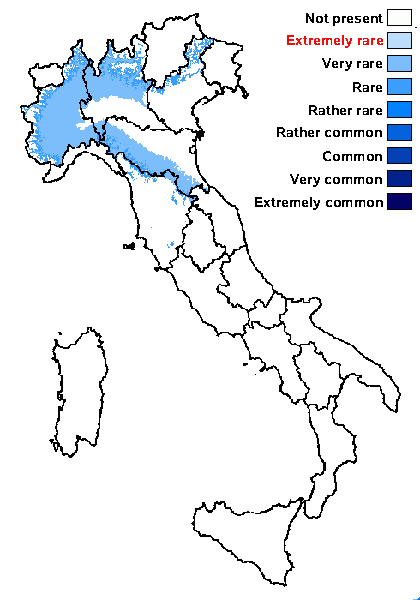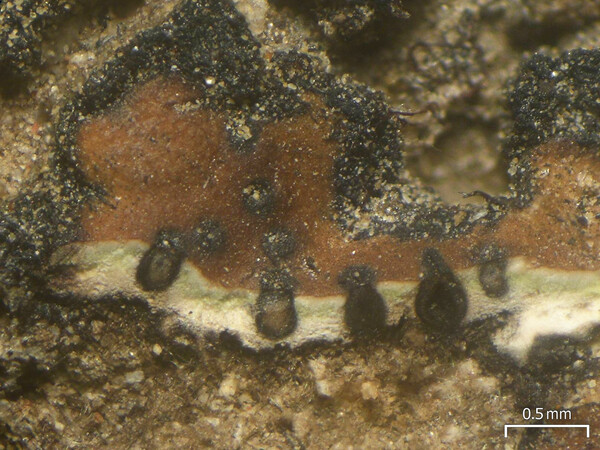Placidium michelii A. Massal.
Sched. Crit., 5: 100, 1856.
Synonyms: Catapyrenium michelii (A. Massal.) R. Sant.; Dermatocarpon michelii (A. Massal.) Zwackh; Endocarpon michelii (A. Massal.) Bausch; Endopyrenium michelii (A. Massal.) Körb.
Distribution: N - Ven (Lazzarin 2000b), Lomb, Piem (Isocrono & al. 2004), Emil (Fariselli & al. 2020). C - Tosc.
Description: Thallus squamulose, the squamules closely adpressed to the substratum, 1-5 mm wide, up to 0.25 µm thick, rounded to undulate, flattened, smooth, scattered to contiguous. Upper surface pale to dark chestnut brown, matt; lower surface black, attached by a dense mat of 4-6 µm thick, colourless rhizohyphae. Upper cortex paraplectenchymatous, 20-65 µm thick, without or with a very thin epinecral layer; medulla of globular cells intermixed with a few elongated cells; lower cortex thin, poorly differentiated, consisting of 1-3 layers of cells, the lower ones pigmented. Perithecia laminal, pyriform, immersed in the squamules, up to 0.35 mm across, without involucrellum. Exciple rather thin (to 25 µm), initially colourless, but soon turning dark brown throughout, starting from the ostiole; paraphyses absent, periphyses measuring 30-40 x c. 2.5 μm. Asci 8-spored, cylindrical, thin-walled, non-amyloid and without an ocular chamber, with uniseriately arranged spores, 60-70 x 10-12 μm. Ascospores 1-celled, hyaline, ellipsoid, thin-walled, 11-15 x 5-6 µm. Pycnidia rare, multilocular, Dermatocarpon-type, laminal, immersed, black. Conidia oblong-ellipsoid, 2.5-3.5(-4) x 1.2-1.5 µm. Photobiont chlorococcoid. Spot tests: cortex and medulla K-, C-, KC-, P-, UV-. Chemistry: without lichen substances.Note: a mainly temperate lichen found on mineral, especially sandy soil in open grasslands. Earlier dubious records from Southern Italy, and that from Latium (see Nimis 1993: 200) are not accepted here.
Growth form: Squamulose
Substrata: soil, terricolous mosses, and plant debris
Photobiont: green algae other than Trentepohlia
Reproductive strategy: mainly sexual
Commonnes-rarity: (info)
Alpine belt: absent
Subalpine belt: absent
Oromediterranean belt: absent
Montane belt: rare
Submediterranean belt: very rare
Padanian area: absent
Humid submediterranean belt: absent
Humid mediterranean belt: absent
Dry mediterranean belt: absent

Predictive model
Growth form: Squamulose
Substrata: soil, terricolous mosses, and plant debris
Photobiont: green algae other than Trentepohlia
Reproductive strategy: mainly sexual
Commonnes-rarity: (info)
Alpine belt: absent
Subalpine belt: absent
Oromediterranean belt: absent
Montane belt: rare
Submediterranean belt: very rare
Padanian area: absent
Humid submediterranean belt: absent
Humid mediterranean belt: absent
Dry mediterranean belt: absent

Predictive model
 INDEX FUNGORUM
INDEX FUNGORUM
 GBIF
GBIF
 DOLICHENS
DOLICHENS


